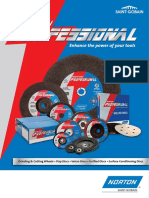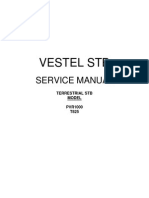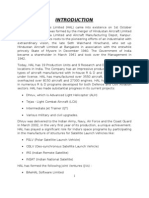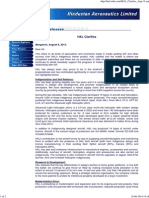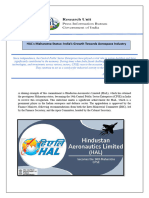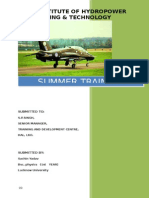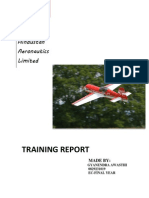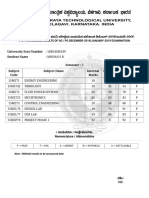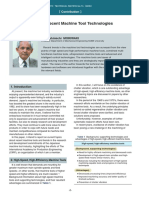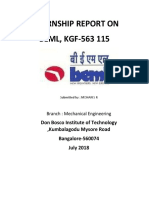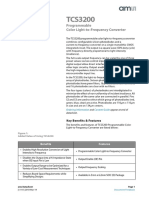VTU Result
VTU Result
Uploaded by
mohan SRCopyright:
Available Formats
VTU Result
VTU Result
Uploaded by
mohan SROriginal Description:
Copyright
Available Formats
Share this document
Did you find this document useful?
Is this content inappropriate?
Copyright:
Available Formats
VTU Result
VTU Result
Uploaded by
mohan SRCopyright:
Available Formats
MAINTAINANCE REPAIR AND OVERHAUL
CHAPTER 1
COMPANY PROFILE
Hindustan Aeronautics Limited (HAL) came into existence on 1st Oct 1964. The
Company was formed by the merger of Hindustan Aircraft Limited with Aeronautics India
Limited and Aircraft Manufacturing Depot, Kanpur.
The Company traces its roots to the pioneering efforts of an industrialist with
extraordinary vision, the late “Seth Walchand Hirachand”, who set up Hindustan Aircraft
Limited at Bangalore in association with erstwhile princely State of Mysore in December 1940.
The Government of India became a shareholder in March 1941 and took over the Management in
1942.
Today, HAL has 16 Production Units and 9 Research and Design Centers in 7 locations in
India. The Company has an impressive product track record 12 types of aircraft manufactured
with in-house R&D and 14 types produced under license. HAL has manufactured 3550
aircraft (which includes 11 types designed indigenously),3600 engines and overhauled over
8150 aircraft and27300 engines.
HAL has been successful in numerous R& D programs developed for both Defense and
Civil Aviation sectors. HAL has made substantial progress in its current projects:
Dhruv, which is Advanced Light Helicopter (ALH)
Tejas – Light Combat Aircraft (LCA)
Intermediate Jet Trainer (IJT)
Various military and civil upgrades.
Department of ME, DBIT 2018-19 Page 1
MAINTAINANCE REPAIR AND OVERHAUL
“DHRUV” was delivered to the Indian Army, Navy, Air Force and the Coast Guard in
March 2002, in the very first year of its production, a unique achievement.
HAL has played a significant role for India’s space programs by participating in the
manufacturing structures for Satellite Launch Vehicles like
PSLV (Polar Satellite Launch Vehicle)
GSLV (Geo Stationary Launch Vehicle)
IRS (Indian Remote Satellite)
INSAT (Indian National Satellite)
There are three joint venture companies with HAL:
BAeHAL Software Limited
Indo-Russian Aviation Limited (IRAL)
Snecma HAL Aerospace Pvt Ltd
Apart from these three, other major diversification projects are Industrial Marine Gas
Turbine and Airport Services. Several Co-production and Joint Ventures with international
participation are under consideration.
HAL’s supplies / services are mainly to Indian Defence Services, Coast Guards and Border
Security Forces. Transport Aircraft and Helicopters have also been supplied to Airlines as well
as State Governments of India. The Company has also achieved a foothold in export in more
than 30 countries, having demonstrated its quality and price competitiveness.
Department of ME, DBIT 2018-19 Page 2
MAINTAINANCE REPAIR AND OVERHAUL
EVOLUTION AND GROWTH OF THE COMPANY
The Company's steady organizational growth over the years with consolidation and enlargement
of its operational base by creating sophisticated facilities for manufacture of aircraft / helicopters,
aero engines, accessories and avionics is illustrated below.
Figure 1.1: Organizational growth HAL
Department of ME, DBIT 2018-19 Page 3
MAINTAINANCE REPAIR AND OVERHAUL
MISSION AND VISION OF A COMPANY
MISSION:
“TO BECOME A GLOBALLY COMPETITIVE AEROSPACE INDUSTRY
WHILE WORKING AS AN INSTRUMENT FOR ACHIEVING SELF RELIANCE
IN DESIGN, MANUFACTURE AND MAINTAINENCE OF AEROSPACE DEFENCE
EQUIPMENT AND DIVERSIFYING TO RELATED AREAS, MANAGING THE
BUSINESS ON COMMERCIAL LINES IN A CLIMATE OF GROWING
PROFESSIONAL COMPETENCE.”
VISION:
“ TO MAKE HAL A DYNAMIC , VIBRANT, VALUE BASED LEARNING
ORGANISATION WITH HUMAN RESOURCES EXCEPTIONALLY SKILLED ,
HIGHLY MOTIVATED AND COMMITTED TO MEET THE CURRENT AND
FUTURE CHALLENGES .THIS WILL BE DRIVEN BY CORE VALUES OF THE
COMPANY FULLY EMBEDDED IN THE CULTURE OF THE ORGANISATION.”
Department of ME, DBIT 2018-19 Page 4
MAINTAINANCE REPAIR AND OVERHAUL
CHAPTER 2
DIVISIONS OF HAL
HAL has 16 Production Units and 9 Research and Design Centers in 7 locations in India.
There are several divisions under Hindustan Aeronautical Limited at Bangalore, They are as
under:
BANGLORE COMPLEX
Aircraft Division, Bangalore
Overhaul Division, Bangalore
Aerospace Division, Bangalore
Engine Division, Bangalore
IGMT Division, Bangalore
Aircraft Services Division, Bangalore
Foundry and Forge Division, Bangalore
Facilities Management Division, Bangalore
Light Compact Aircraft Division, Bangalore
Aero Engine Research and Design Centre Division, Bangalore
Helicopter MRO Division, Bangalore
Composite Manufacturing Division, Bangalore
Design Complex Division, Bangalore
Facilities Management Division, Bangalore
Department of ME, DBIT 2018-19 Page 5
MAINTAINANCE REPAIR AND OVERHAUL
CHAPTER 3
INTRODUCTION
Hindustan Aeronautics Limited (HAL) is an Indian state-owned aerospace and defence
company headquartered in Bangalore, India. It is governed under the management of the Indian
Ministry of Defence.
The government-owned corporation is primarily involved in the operations of the aerospace and
is currently involved in the design, fabrication and assembly of aircraft, jet engines, helicopters
and their spare parts. It has several facilities spread across India including Nasik, Korwa,
Kanpur, Koraput, Lucknow, Bangalore, Hyderabad and Kasaragod. HAL HF-24 Marut fighter-
bomber was the first fighter aircraft made in India.
Brief History
Hindustan Aeronautic Limited [HAL] a premier Aerospace Company in Asia is engaged
in design, development and manufacture of military and civil aircraft for over 75 years. The
product range covers basic piston engine trainer aircraft to helicopters to sophisticated state of
the art deep penetration strike aircraft. Hindustan Aeronautic Limited is an organization where
integrated air borne weapons platforms are conceived, developed, manufactured and serviced. It
is one of the few corporate giants in Asia whose capabilities span the entire range of activities
from product conception to after sale support. HAL is also involved in the manufacture and
assembly of structures required for India's space programs.
The Company which had its origin as the Hindustan Aircraft Company was incorporated
on 23 Dec 1940 at Bangalore by Shri Walchand Hirachand a farsighted visionary in association
with the Government of Mysore with an Authorised Capital of Rs.4crores (Paid up capital Rs.40
lakhs) and with the aim of manufacturing aircraft in India. In March 1941, the Government of
India became one of the shareholders in the Company holding 1/3 of its paidup capital and
subsequently took over its management in 1942.
Department of ME, DBIT 2018-19 Page 6
MAINTAINANCE REPAIR AND OVERHAUL
Hindustan Aeronautics Limited (HAL) came into existence on 1st October 1964. The
Company was formed by the merger of Hindustan Aircraft Limited with Aeronautics India
Limited and Aircraft Manufacturing Depot, Kanpur. HAL is a fully owned Government of India
undertaking under the administrative control of Ministry of Defence, Department of Defence
Production. H.A.L is the largest Public Sector Unit (PSU) under the department of Defence
production and is a Navaratna Company.
HAL is currently meeting the requirements of structures for aerospace launch vehicles
and satellites of ISRO through its dedicated Aerospace Division. Infrastructure has also been set
up to undertake completed assembly of the strap-on L-40 stage booster. Structures for GSLV Mk
III have been productionised. HAL has also contributed to Mars mission by supplying riveted
structural assemblies and welded propellant tankages for the Polar Satellite Launch Vehicle
(PSLV-C25).
Today, HAL has 19 Production Units and 9 Research and Design Centers in 7 locations
in India. The Company has impressive product track record-12 types of aircraft manufactured
with in-house R&D and 14 types produced under license. HAL has manufactured 3550 aircraft
(which includes 11 types designed indigenously), 3600 engines and overhauled over 8150
aircraft and 27300 engines.
HAL has made substantial progress in its current projects :
Dhruv- Advanced Light Helicopter – Weapon System Integration (ALH-WSI)
Tejas - Light Combat Aircraft (LCA)
Intermediate Jet Trainer (IJT)
Various military and civil upgrades.
Light Combat Helicopter (LCH)
Department of ME, DBIT 2018-19 Page 7
MAINTAINANCE REPAIR AND OVERHAUL
ENGINE SYSTEM
INTRODUCTION:
Advanced Light Helicopter (ALH) is powered by two Turbo Meca TM 333 2B2 engines.
The TM-333-2B2, is a free turbo shaft engine of the 80kw (1073shp) class, intended to power
medium class twin engine advanced light helicopter. The power turbine is independently
connected to the main gearbox. The engines are of modular construction and modules can be
replaced in unit level without sending engine back to the manufacturer.
Figure 3.10: Turbo Meca TM 333 2B2 engine
ADVANCED FEATURES OF ALH ENGINE
1.Cold end free turbo shaft engine.
2.Modular construction.
3. Simple and reliable components.
4. Engine is controlled by the electronic controller called Full Authority Digital Engine Control
(FADEC) with provision for manual control of fuel flow by pilot's, in case of FADEC control
failures.
MODULAR CONSTRUCTION OF THE ENGINE:
The turboshaft engine of ALH is of modular construction. Each module consist of free
balanced sub assembly which is easily exchangeable without the need for any adaptation work
and the used of complex tools and test benches.There are two modules in this engine.
Department of ME, DBIT 2018-19 Page 8
MAINTAINANCE REPAIR AND OVERHAUL
Module1 (MO1):
Reducing gearbox
Accessory drive
Air intake
Module2 (MO2):
Inlet guide vanes
Compressors
Combustion chamber
Power turbine
HP turbine
Advantages of modular construction:
It enable easy assembly and disassembly
Each module is interchangeable with other engines
It avoids the complete engine return to a specialised workshop
Reduction of maintenance costs
INTEGRAL SYSTEM OF THE ENGINE
The TM 333-2B2 engine consists of the following system
1. Air Systems
2. Fuel systems
3. Oil system
4. Starting and Ignition system
5. Indicating system
6. Electrical system
7. Control system
Department of ME, DBIT 2018-19 Page 9
MAINTAINANCE REPAIR AND OVERHAUL
AIR SYSTEM:
The main function of the air system is to supply the required quantity of weight according to the
engine requirement under all operating conditions. Additional the air system performs secondary
functions like pressurization of labyrinth seals, ventilation of starting injectors,P3 project tapping
to the transmitter for FADEC function and air bleed for aircraft heating and ventilation system.
FUEL SYSTEM
The main function of the fuel system is to supply the required quantity of the fuel into the
combination chamber under all operating conditions. Engine fuel system is subdivided into four
system.
1. Low pressure fuel system
2. High pressure fuel system
3. Fuel injection system
4. IGV actuating system
The engine fuel systems, FADEC, an engine starting system/shutdown system, electrical system
are closely interfaced with one another.
ELECTRICAL SYSTEM:
The engine electrical system provide the following electrical details for the harnesses.
a. From engine to FADEC and accessories
b. From cockpit to FADEC and vice versa
c. Engine to cockpit and vice versa.
CONTROL SYSTEM :
The principal engine control is to regulate the fuel supply to the engine based and different load
requirement and conditions. The engine controls includes maintenance of constant free Turban
speed and main rotor speed, free turbine overspeed protection, selection of contingency and
training waiting and control of inlet guide vane.
Department of ME, DBIT 2018-19 Page 10
MAINTAINANCE REPAIR AND OVERHAUL
The control is entirely electronic and called full authority digital engine control(FADEC).
The heart of the FADEC is the electronic calculator. After the electronic calculator is referred to
as FADEC, digital engine control unit (DECU),or engine control unit (EECU).
Figure 3.11: digital engine control unit (DECU)
PRINCIPAL OF OPERATION AND CONSTRUCTION:
The TURBOMECA 333-2B2 engine is a turbo shaft engine in the 801kw(1073shp) class.
It operates on the principle of the brayton thermodynamics cycles.
This engine is of free turbine type.
The connection to the MGB and of the free turbine is at the cold end (the free turbine
shaft rotates inside the gas generator turbine shaft). Shaft horsepower is taken from free
turbine shaft.
This engine consist of two stage axial flow compressor preceded by a row of variable
inlet guide vanes, single stage, centrifugal flow compressor, single stage gas generator
turbine and single stage power turbine or free turbine
The free turbine shaft is located inside the gas generator turbine shaft.
There is no mechanical connection between gas generator turbine and power turbine.
The fuel consumed buy this engine is standard Aircraft Turbine Fuel(ATF) that has a
density of about 0.77kg/litre. This fuel is cheaper than diesel.
Department of ME, DBIT 2018-19 Page 11
MAINTAINANCE REPAIR AND OVERHAUL
The air intake by the compressor is annular. This compressor are given by the single
stage gas generator turbine.
The combustion chamber employed in theses engine are annular reverse flow type.
The single stage free Turban with a true short driving A reduction gear.
Reduction gear casing also having accessory gearbox driven by gas generator.
Air intake is similar (annular) to engine axis.
Exhaust Jet pipe with Central cone is attached and diffuser.
TURBOMECA 333-2B2 ENGINE SPECIFICATION
Model TM-333 m/s Turbomeca(FRANCE)
Version 2B2
Power Output 801KW
Length 1045mm
Breadth 450mm
Width 745mm
Weight 166.5Kg
Output Shaft speed 6000rpm
Gas generator speed 45000rpm
Power turbine speed 37562rpm
Operating altitude 500m to 7000m
Operating temperature -50’C to 50’C
Fuel used ATF K-50
Oil used MIL-L-23699(Jet oil 2)
Table 3.1: Turbomeca 333-2B2 engine specification
Department of ME, DBIT 2018-19 Page 12
MAINTAINANCE REPAIR AND OVERHAUL
ENGINE DESCRIPTION AND OPERATION
1. INTRODUCTION:
The TM 333-2B2 is a turbo shaft engine designed to meet the power requirements of new
generation helicopters
The design of this engine is based on:
a) An optimized thermodynamic cycle
b) Simple and reliable components
c) High performance
d) Reduction of operating costs
2. THERMODYNAMIC CYCLE :
The turbo shaft engine operates on Brayton Cycle as shown in diagram. This turbo shaft engine
is similar to IC engines. The main differences between the IC Engine and turbo shaft engine are
as follow.
CARBURETOR ENGINE TURBOSHAFT ENGINE
(OTTO CYCLE)
Combustion occurs at constant volume Combustion occurs at constant pressure
Operating phases are intermittent Operating phases are continuous
Department of ME, DBIT 2018-19 Page 13
MAINTAINANCE REPAIR AND OVERHAUL
3. WORKING PRINCIPLE:(BRAYTON CYCLE):
Figure 3.12: working principle of gas turbine cycle
The above fig. Shows the working principle of gas turbine cycle. The working cycle upon which
the gas turbine engine is in its simplest form represented by the cycle shown on the pressure
volume diagram. Point A represents air at atmospheric pressure that is compressed along the line
AB, from B to C heat is added to the air by introducing and burning fuel at constant pressure
there by considerably increasing the volume of air . The pressure drop in the combustion
chamber are indicated the drop between B and C. From C to D the gases resulting from
combustion expand through the turbine and jet pipe. During this part of cycle the energy (kinetic
energy, pressure energy) from the gases are converted into mechanical power
4. DESCRIPTION AND OPERATION:
The cross sectional view of the TM 333-2B2 Turbo shaft engine . The following stages are
involved in this turbo shaft engine operation. Fig.4 shows the PVT diagram for the engine
operation.
A. Admission
A - B Compression
B - C Combustion
C - D Expansion
D - A Exhaust
Department of ME, DBIT 2018-19 Page 14
MAINTAINANCE REPAIR AND OVERHAUL
HYDRAULIC SYSTEM
Introduction:
Hydraulic systems operate simultaneously and independently. When one
system fails, the other system continues to operate.
Hydraulic system is divided into three main modules
The first module is the hydraulic pump,
The second module is the hydraulic package
The third module is the operating equipment
(hydraulic actuator).
Figure 3.13: Hydraulic system
Hydraulic pumps and packages of system 1 and 2 are physically located on the port and
starboard side respectively. System pressure and system return hydraulic lines emerging out of
the two hydraulic packages are connected to a pair of hydraulic distribution manifold mounted
on the main gearbox.
The three main rotor actuators namely collective actuator, pitch actuator and roll actuator are
installed in front of the main gearbox with direct link to the pressure and return hydraulic lines of
system 1 and 2 through the hydraulic manifold. The tail rotor actuator is installed on the tail
gearbox and hydraulically connected to system 1 and 2 through lines running along the tail boom
and vertical fin with the hydraulic system link at the hydraulic manifold.
Department of ME, DBIT 2018-19 Page 15
MAINTAINANCE REPAIR AND OVERHAUL
Figure 3.14: Block diagram of “DHRUV” Control Hydraulic System
Basic Specifications:
Following are the specifications for each of the three hydraulic systems of Dhruv.
Normal operating pressure : 206 + 4 bar
Operating pressure range : 185 to 220 bar
Maximum flow rate : 25 lt. Per minute
Operating temperature range of the fluid : - 40 to + 107 deg. C
Extreme temperature of the fluid : - 54 to + 135 deg. C
Outside air temperature : - 45 to + 54 deg. C
Hydraulic fluid : MIL-H-5606E or Equivalent
Fluid cleanliness : NAS 1638 class8 or better
Department of ME, DBIT 2018-19 Page 16
MAINTAINANCE REPAIR AND OVERHAUL
HYDRAULIC PUMP:
It is used to supply a continuous, pressurized, low pulsating flow of hydraulic fluid.
Hydraulic pump is of axial piston, variable delivery, and constant pressure type.
Used for converting a rotary mechanical force into a reciprocating piston action produces the
pumping action of the pistons.
The pump is driven by the main gear box (MGB)
The rotary movement of the shaft is converted into axial movement of the pistons through a
swash plate/yoke whose angle (inclination) with respect to the shaft can be varied there by
altering the stroke of the pistons and the delivery. Hence the term variable delivery.
Figure 3.15: Hydraulic pump
Pump has four hydraulic connections, namely
Suction
Delivery
Case drain
Seepage drain
Department of ME, DBIT 2018-19 Page 17
MAINTAINANCE REPAIR AND OVERHAUL
OPERATION
As the external prime mover starts to turn, the movement is transmitted through coupling shaft to
drive shaft and cylinder block. In this condition, yoke, ball and pin subassembly is held at its
maximum angle of displacement in relation to the drive shaft axis by outer and inner springs
through spring guide .As cylinder block turns, the shoes of the seven pistons and shoe
subassemblies operate on the angled face of shoe bearing plate .This causes the seven piston
barrels to move up and down in their related holes in the cylinder block. As pistons move away
from the valving face of the cylinder block, they align with a kidney shaped inlet slot in valve
plate and bearing subassembly .This lets fluid flow from the hydraulic system connected to the
inlet connection of the valve plate and bearing subassembly into the piston holes of cylinder
block .As cylinder block continues to rotate, the pistons of the seven piston and shoe
subassemblies move towards the valve face of the cylinder block where they align with a kidney
shaped outlet slot in valve plate and bearing subassembly .This lets the pressurized fluid in the
cylinder block holes flow through the valve plate subassembly to the outlet connection. Each
piston completes the inlet (suction) and outlet (delivery) cycle during one turn of the cylinder
block. This gives a continuous, low pulsating flow of fluid to the hydraulic system.
HYDRAULIC PACKAGE:
In modern helicopters all control valves as well as the reservoir are clubbed into a
single unit referred to as hydraulic package.
Figure 3.16: hydraulic package
Department of ME, DBIT 2018-19 Page 18
MAINTAINANCE REPAIR AND OVERHAUL
Each control hydraulic system has one package.
The package comprises of mainly
Reservoir with a piston (low pressure cylinder and piston assembly)
High pressure cylinder and piston assembly
Reservoir excess pressure relief valve
System high pressure relief valve
Pressure line filter assembly
Return line filter assembly
Fluid level indicator
Bleed valve
Filter and check valve assembly of pump case drain line
Pressure transducer
Pressure switch
Low level (proximity) sensor
Temperature switch
Working of hydraulic package:
The hydraulic package used in Dhruv makes use of the pressurized hydraulic fluid from the
hydraulic pump to pressurize the fluid in the reservoir and hence known as the self pressurized
system. It is also referred to as bootstrap reservoir. The working of hydraulic package is
explained with the fig.
a. The system pump draws the fluid from the cylinder / reservoir through suction line (PS).
Pump output returns to the hydraulic package through the check valve at the pump pressure port
(PP).The pressurized fluid down stream of the check valve is available at the high pressure relief
valve and at the high pressure filter . Some amount of fluid sucked by the pump is utilized for
lubrication of pump components. The fluid is drained through case drain line (PC) and sent back
to the reservoir through filter and check valve.
Department of ME, DBIT 2018-19 Page 19
MAINTAINANCE REPAIR AND OVERHAUL
b. The supply from the HP filter is available at system pressure (SP) and at the bottom side
of the HP piston in the high-pressure cylinder. Pressure applied at the bottom of the HP piston
will lift the HP piston and in turn the LP piston also. The upward movement of LP piston will
pressurize the fluid in the LP cylinder / reservoir up to 3 bars. This fulfills the requirement of the
pump ensuring the fluid pressure at the suction is above 1.5 bar. This prevents cavitation in the
pump suction line (PS). Air displaced from the full-bore or top side of the HP piston is vented to
atmosphere through the bleeder at the top of the high-pressure cylinder. As the LP piston moves
up the piston draws air through the filter disc in the base of the cylinder.
c. The pressure switch installed in the pressure line senses the low pressure situation and
makes the warning light HYD1/HYD2 to come ON in the CWP. At a pressure below 140 bar
(158 to 140 bar), the contacts of the switch are set by its spring and a warning light comes ON in
CWP. At an increasing pressure above 180 bar (162 to 180 bar), the contact of the switch change
over against the spring pressure and the warning light goes OFF. This demonstrates that the
system is at operating pressure and ready for use.
d. The pressure sensor monitors pressure (Zero to maximum) in the pressure supply line and
the pressure is indicated by the gauge in the cockpit.
e. If the pressure in the service pressure (SP) line rises above 258 bar, the high pressure
relief valve opens and relieves the excess fluid to the service return line (SR). The valve closes at
233 bar.
f. The return fluid from the system / actuator is available at service return (SR) and from
here it flows through return filter which has got a bypass valve to the reservoir .A temperature
switch is provided in the return line for fluid high temperature (above 100℃) warning purposes.
Warning is not available in the cockpit.
g. A rise in the cylinder / reservoir pressure above 12 bar causes the poppet of the low-
pressure relief valve to open against the spring pressure. This vents fluid to the over pressure
relief line (DP) which is opened to atmosphere. The valve closes at 10 bar. The low-pressure
relief valve also protects the reservoir/cylinder against over pressure during the filling.
Department of ME, DBIT 2018-19 Page 20
MAINTAINANCE REPAIR AND OVERHAUL
1. Check Valve
2. Bleed Valve (press to bleed)
3. Reservoir
4. HP Relief Valve
5. HP Filter (with Clogging Indicator)
6. Pressure Switch
7. Pressure Transducer
8. LP Filter (with Clogging Indicator)
9. Filter By Pass Valve
10. LP Relief Valve
(reservoir excess pressure relief)
11. Case Drain Non Return Valve
12. Low Level sensor assembly
13. Temperature Switch
14. Case Drain Filter
Figure4.3.17: pacakage operation schematic representation
HYDRAULIC ACTUATORS:
Operating the main and the tail rotor upper controls.
These actuators are hydraulically powered and transmit the cockpit control input to the
rotors by amplifying the efforts put by the pilot.
Two independent hydraulic systems are dedicated to power all the actuators in all the
channels.
Figure 3.18: hydraulic actuators
Department of ME, DBIT 2018-19 Page 21
MAINTAINANCE REPAIR AND OVERHAUL
Unit Description:
The constructional details of main rotor actuator and tail rotor actuator are the same
except that main rotor actuator has a duplex CSAS whereas the tail rotor actuator has a simplex
CSAS.
The main components of main actuator are
a. Main actuator assembly & load bearing structures
b. Distributor valve and filter assembly
c. Input lever and other linkages
d. Feed back lever
e. Hydraulic lines
The CSAS actuators are integral part of the main hydraulic actuators.
The main components of CSAS actuator are
f. CSAS actuator with by pass valve and linkages
g. Electro hydraulic servo valve (EHSV)
h. Solenoid valve
Figure 3.19: main components of main actuator
BASIC FLIGHT THEORY
How lift is generated?
Newton’s Laws of Motion and Bernoulli’s Principle are used to explain lift.
Bernoulli – Bernoulli’s Principle states that, as air speeds up, its pressure goes down.
He focused his studies on the curvature of the wing, and the differing air pressure over the
top and bottom of the wing.
Department of ME, DBIT 2018-19 Page 22
MAINTAINANCE REPAIR AND OVERHAUL
Newton – Newton’s Third Law states that for every action there is an equal and opposite
reaction.
He focused his studies on the deflection of air or fluid on an object and its reaction.
(Newton’s 3rd Law)
To explain the lift phenomena we have to understand the meaning of Aerofoil structure
Airfoil
An airfoil is the shape of a wing or blade (of a propeller, rotor or turbine) as seen in
crosssection. An aircraft's wings, horizontal, and vertical stabilizers are built with airfoil-shaped
cross sections.
Figure 3.20: Bernoulli’s Principle
As the air flows over the upper surface of an airfoil, its velocity increases and its pressure
decreases; an area of low pressure is formed. There is an area of greater pressure on the lower
surface of the airfoil, and this greater pressure tends to move the wing upward. The difference in
pressure between the upper and lower surfaces of the wing is called lift. Three-fourths of the
total lift of an airfoil is the result of the decrease in pressure over the upper surface.
Department of ME, DBIT 2018-19 Page 23
MAINTAINANCE REPAIR AND OVERHAUL
An aircraft in flight is acted upon by four forces:
Gravity or weight: the force that pulls the aircraft toward the earth. Weight is the force of
gravity acting downward upon everything that goes into the aircraft, such as the aircraft
itself, crew, fuel, and cargo.
Lift: the force that pushes the aircraft upward. Lift acts vertically and counteracts the effects
of weight.
Thrust: the force that moves the aircraft forward. Thrust is the forward force produced by the
power plant that overcomes the force of drag.
Drag: the force that exerts a braking action to hold the aircraft back. Drag is a backward
deterrent force and is caused by the disruption of the airflow by the wings, fuselage, and
protruding objects.
Figure 3.21: Forces in action during flight
Department of ME, DBIT 2018-19 Page 24
MAINTAINANCE REPAIR AND OVERHAUL
TRANSMISSION SYSTEM
INTRODUCTION:
Power from the engines is combined in the main gearbox (MGB) and
transmitted to the main rotor.
The tail rotor drive shaft is driven from the MGB and transmits power through
flexibly coupled shafts, anauxiliary gearbox, intermediate gearbox and a tail
rotor gear - box to the tail rotor.
The power from the MGB is also used for driving various accessories
arranged in two distinct areas; LH & RH sides of MGB, which consists of
Hydraulic - pump drive, an alternator drive and a lubricating pump drive
Assemblies of Transmission System:
Transmission system consists mainly of:
1. Main gear box
2. Auxiliary gear box
3. Intermediate gear box
4. Tail gear box
5. Tail drive shaft
6. Anti-resonance isolation system (ARIS)
Figure 3.22: transmission system
Department of ME, DBIT 2018-19 Page 25
MAINTAINANCE REPAIR AND OVERHAUL
Based on speed variation there are several gear boxes which are employed as follows;
1. Main gear box (MGB)
2. Auxiliary gear box (AGB)
3. Intermediate gear box (IGB)
4. Tail rotor gear box (TGB)
1. MGB (Main Gear Box)
Figure 3.23: main gear box
It receives the motion from the engine and transfers it to main rotor, in order to rotate the main
rotor blades. The output from the engine in RPM is very high and of low torque, thus MGB
increases the torque by reducing the speed. Simultaneously transmits the motion to the Tail
gearbox through the Auxiliary and Intermediate gearboxes. Figure 2 shows Main Gear Box of
Advanced light helicopter.
2.AGB (Auxillary Gear Box)
Figure 3.24: Auxiliary gear box
Department of ME, DBIT 2018-19 Page 26
MAINTAINANCE REPAIR AND OVERHAUL
The lubricating oil in the MGB gets heated to a temperature of around 100o , in order to reduce
the temperature of oil, so that the lubricating capacity of the oil is in tact, AGB is provided which
is used to cool the MGB oil and re-circulate the cooled oil to the MGB. It is also used to drive
various auxiliary equipments and to transmit power to IGB. Tail drive shafts are used to transmit
the motion from Auxiliary gearbox to Tail gearbox through Intermediate gearbox.
Sliding spline connection is provided between the IGB and the TGB (i.e. Shaft between
the IGB and TGB). This accommodates mounting tolerances and differential thermal expansion
of tail rotor drive shaft and tail boom structure.
3. IGB (Intermediate Gear Box)
Figure 3.25: Intermediate gear box
Intermediate gearbox is mounted on the tail boom at its intersection with the canted vertical
fin. It has one stage of spiral bevel gearing which serves to redirect the driveline upward to the
tail gearbox through a 125° angle. It also provides a small speed reduction (i.e. the speed
reduction ratio is 4163/4033). The estimated dry weight of the IGB assembly is 15 kg.
4. TGB (Tail Gear Box)
The main purpose of the Tail gearbox is to drive the tail rotor blade by receiving the power
from the IGB by means of a tail drive shaft. The basic purpose of the tail rotor blade is to give a
force in a direction opposite to the force generated by the main gear box by virtue of friction
which tries to rotate the whole of the helicopter with it , such that the whole of the helicopter is
in a stable position during the course of the flight.
Department of ME, DBIT 2018-19 Page 27
MAINTAINANCE REPAIR AND OVERHAUL
Figure 3.26: Tail gear box
TAIL
NO PARTICULARS UNITS INPUT COLLECTOR POWER
TAP OFF
1 NUM OF 27/79 17/111 17/111
TEETH
Driving Member
2 Pinion Pinion Gear
3 Pinion speed RPM 6000 2050.63 2050.63
4 Gear Speed RPM 2050.63 314.06 314.06
DESIGN POWER 280KW
Department of ME, DBIT 2018-19 Page 28
MAINTAINANCE REPAIR AND OVERHAUL
TAIL ROTOR SYSTEM
The tail rotor drive system consists of a tail rotor drive shaft powered from the main
transmission and a tail rotor transmission mounted at the end of the tail boom. The drive shaft
may consist of one long shaft or a series of shorter shafts connected at both ends with flexible
couplings. This allows the drive shaft to flex with the tail boom. The tail rotor transmission
provides a right angle drive for the tail rotor and may also include gearing to adjust the output to
optimum tail rotor RPM
Figure 3.27: Tail rotor system
MAIN ROTAR SYSTEM
The primary purpose of the main rotor transmission is to reduce engine output RPM to
optimum rotor RPM. Suppose the engine speed of a specific helicopter is 2,700 RPM.
Achieving a rotor speed of 450 RPM would require a 6 to 1 reduction. A 9 to 1 reduction would
mean the rotor would turn at 300 RPM. Most helicopters use a dual-needle tachometer to show
both engine and rotor RPM or a percentage of engine and rotor RPM. The rotor RPM needle
normally is used mostly during clutch engagement to monitor rotor acceleration and in
autorotation to maintain RPM within prescribed limits. See figure 3.26.
Department of ME, DBIT 2018-19 Page 29
MAINTAINANCE REPAIR AND OVERHAUL
In helicopters with horizontally mounted engines, another purpose of the main rotor
transmission is to change the axis of rotation from the horizontal axis of the engine to the vertical
axis of the rotor shaft.
Figure 3.28:Dual needle Tachometer of Main gear system
Figure 3.29:Main Rotor System
Department of ME, DBIT 2018-19 Page 30
MAINTAINANCE REPAIR AND OVERHAUL
CLUTCH
Owing to the greater weight of a rotor in relation to the power of the engine, as compared
to the weight of a propeller and the power in an airplane, the rotor must be disconnected from the
engine when you engage the starter. A clutch allows the engine to be started and then gradually
pick up the load of the rotor. On free turbine engines, no clutch is required, as the gas producer
turbine is essentially disconnected from the power turbine.
When the engine is started, there is little resistance from the power turbine. This enables
the gas producer turbine to accelerate to normal idle speed without the load of the transmission
and rotor system dragging it down. As the gas pressure increases through the power turbine, the
rotor blades begin to turn, slowly at first and then gradually accelerate to normal operating RPM.
FREEWHEELING UNIT
Since lift in a helicopter is provided by rotating airfoils, these airfoils must be free to
rotate if the engine fails. The freewheeling unit automatically disengages the engine from the
main rotor when engine RPM is less than main rotor RPM. This allows the main rotor to
continue turning at normal in-flight speeds. The most common freewheeling unit assembly
consists of a one-way “sprag” clutch located between the engine and main rotor transmission.
This is usually in the upper pulley in a piston helicopter or mounted on the engine gearbox in a
turbine helicopter.
When the engine is driving the rotor, inclined surfaces in the sprag clutch force rollers
against an outer drum. This prevents the engine from exceeding transmission RPM. If the engine
fails, the rollers move inward, allowing the outer drum to exceed the speed of the inner portion.
The transmission can then exceed the speed of the engine. In this condition, engine speed is less
than that of the drive system, and the helicopter is in an autorotative state.
Department of ME, DBIT 2018-19 Page 31
MAINTAINANCE REPAIR AND OVERHAUL
FLIGHT CONTROL SYSTEM
In advanced light helicopter (Dhruv), flight control system consist of duplicated Cockpit
controls for pilot and co-pilot to operate, which in turn controls the main rotor blades and tail
rotor blades through conventional mechanical linkages and fully powered hydraulic actuators
which are operated by two independent hydraulic system.
Control system comprises of:
1 .Collective control (using collective sticks): for controlling helicopters up and down
movement.
2 .Cyclic longitudinal control (using cyclic stick): for controlling the forward and backward
movement of helicopter .
3 .Cyclic lateral control (using cyclic stick): for controlling the left or right movement of
helicopter.
4.Directional control or tail rotor control (using rubber pedals):for controlling the yawing
movement of helicopter towards right or left .
5.Control rod vibration isolation system :the control rod vibration isolation system (VSI) is
incorporated to eliminate relative movement between the Servo actuators And lower leakage
.This is available for the main rotor actuators-pitch ,roll , collective. The VSI countries of a
spicing arm hinged to the structure (a bracket on top of center post)and a rod,which connects
swinging arm and vibrating main Rotor actuator.
6.Force feel and trim system (FFS):this is an electro mechanical unit which gives Artificial feel
and trim facility to the pilot .There is one FFS connected in parallel for Each channel .They are
also interface with AFCS (Automatic flight control system).
7.Push pull rods and bell cranks :The cockpit control movement is transferred through rotor
actuators through push pull rods and bell cranks.
The main rotor upper control system (UCS) consist of swinging arm, swash plate, control rods
etc. are housed inside the main gear box as part of integrated dynamic system (IDS).
Department of ME, DBIT 2018-19 Page 32
MAINTAINANCE REPAIR AND OVERHAUL
: swash plate is located inside the MGB with its axis coincident with rotor axis . It
provides the vertical axis for the sliding motion of the swash plate mechanism .Swash plate
assembly moves up and down on the mast depending on the collective input.
: this is the essential component for collective and cyclic pitch
variation. It consists of rotating and non rotating parts separated by a ball bearing.The spherical
bearing at the centre of swash plate allows the swash plate to side up and down on mast and to
tilt in all planes around the bearing centre.
rods constitute the vertically positioned, equi-spaced Four control
rods attached to the rotating swash plate. The lower end of the rotating control rods follow the
swash plate plane. The upper end of these rods are connected to horn, which in turn act as pitch
change lever.
:these 3 control rods connects the longitudinal BellCrank,
Latitudinal Lever and Lateral Bell crank of mixing unit to non rotating swash plate at these
points. Longitudinal lever is assembled on collective bell crank and Lateral bell crank hence
known as cyclic hinge.
MAIN ROTOR LOWER FLIGHT CONTROL SYSTEM:
The collective lever is pivoted on a bracket, which in turn is mounted on the floor board.
Collective lever movement is transmitted through a link rod to a torque tube, which runs across
the cockpit floor and supported by bearings at 3 places .The torque tube also provides inter
connection between the pilot and co-pilot collective lever.
The moment of the bell crank is transmitted to the input lever of the collective actuator mounted
on MGB housing through a connecting rod
The movement of the input lever operates the distributor are pilot operated valve in the actuator.
The high pressure fluid acts on the actuator piston and make it to move.
The position moment is transferred to collective bell crank of mixing unit through collective
connecting rod forming part of upper control system. The collective bell crank rotates about
Department of ME, DBIT 2018-19 Page 33
MAINTAINANCE REPAIR AND OVERHAUL
collective hinge axis and as a result cyclic hinge moves up or down, pitch in turn move all non-
rotating control rods up and down. When the collective lever moves upwards, the swash plate
will be moved down, increasing the pitch angle of the plates and vice versa.
The upper control system is from the output of actuator located on TGB total rotor blade pitch
change mechanism. The swash plate assembly is used to provide vibrations in collective and
cyclic pitch. It consists of rotating and non rotating parts separated by ball bearing.
ALH(ADVANCED LIGHT HELICOPTER)
The body and the associated components of the helicopter are mostly made of composite and
other light materials which reduces the weight of the helicopter hence the name ALH.
Based on mechanical construction the helicopters are classified as :
1. Skid version.
2. Wheel version.
1. Skid version
Figure 3.30: skid version
Department of ME, DBIT 2018-19 Page 34
MAINTAINANCE REPAIR AND OVERHAUL
Skid version is preferred by Indian army and Indian air force, because irrespective of the land
conditions (flat/steep) the helicopter can be landed easily.
Figure above shows the skid version of helicopter used in Indian army.
2 .Wheel version
Figure 3.31: wheel version
Wheel version is mostly preferred by Indian navy and coast guard, since the helicopter has to be
landed on the flat surface of moving ship.
Above figure shows the wheel version of helicopter used in Indian navy.
Wheel version is further classified as
Fixed wheel
Retractable wheel
If the wheels remain rigidly fixed to the body of the helicopter during all the time (flight or
landing) then such type of wheel version is known as fixed.
If wheel gets folded into the body of helicopter during flight and are opened during landing, then
such type of wheel version is known as retractable.
Department of ME, DBIT 2018-19 Page 35
MAINTAINANCE REPAIR AND OVERHAUL
Based on the display system of cockpit and the type of engines employed the helicopters are
classified as MARK 1, MARK 2, MARK 3 and MARK 4.
MARK 1 MARK 3
Display system –analogue. Display system-digital
Engine-TM333-2B2. Engine –shakti.
Power-800kw. Power-900-1027kw
Figure 3.32: Mark 1 display
MARK 2 MARK 4
Display system-digital. Display system-digital.
Engine –TM333-2B2. Engine-shakti.
Power-800kw.
Figure 3.33: Mark 2 display
Department of ME, DBIT 2018-19 Page 36
MAINTAINANCE REPAIR AND OVERHAUL
Dhruv
Dhruv (sarang) helicopter of the Indian Air Forces
Role Multirole helicopter
National origin India
Manufacturer Hindustan Aeronautics Limited
First flight 20 August 1992
Introduction March 2002
Status In service
Primary users IndianArmy
Indian Navy
Produced 1992–present
Number built 231 as of February 2017
Department of ME, DBIT 2018-19 Page 37
MAINTAINANCE REPAIR AND OVERHAUL
The HAL Dhruv is a utility helicopter developed and manufactured by India's Hindustan
Aeronautics Limited (HAL). The development of the Dhruv was first announced in November
1984, and it was subsequently designed with assistance from MBB in Germany
Military versions in production include transport, utility, reconnaissance and medical evacuation
variants. Based on the Dhruv platform, the HAL Light Combat Helicopter (LCH) a dedicated
attack helicopter and HAL Light Utility Helicopter (LUH), a utility and observation helicopter,
are currently being developed. As of August 2013, more than 200 HAL Dhruv have been
produced for different customers.
Figure 3.34: Dhruv In Indian army
Specifications:
Data from Indian Army, HAL
General characteristics:
Crew: 1 or 2 pilots
Department of ME, DBIT 2018-19 Page 38
MAINTAINANCE REPAIR AND OVERHAUL
Capacity: 12 passengers (14 with high density seating); or 4 stretchers with 2 attendants; or 2
stretchers with 4 attendants
Length: 15.9 m (52 ft 2 in)
Width: 13.2 m (43 ft 4 in)
Height: 4.98 m (16 ft 4 in)
Empty weight: 2,502 kg (5,516 lb)
Max takeoff weight: 5,500 kg (12,125 lb)
Fuel capacity: 1400 liters
Powerplant: 2 × HAL Shakti Turboshaft, 899 kW (1,206 hp) each . Used in Mk III and Mk IV.
Powerplant: 2 × Turbomeca TM 333 Turboshaft, 801 kW (1,074 hp) each . Used in Mk I and
Mk II.
Main rotor diameter: 13.20 m (43 ft 4 in)
Performance:
Maximum speed: 295 km/h (183 mph; 159 kn)
Range: 640 km (398 mi; 346 nmi)
Endurance: 3h 42m
Service ceiling: 6,096 m (20,000 ft)
Rate of climb: 10.3 m/s (2,030 ft/min)
Armament:
Missiles: 8 Anti-tank guided missiles
4 Air-to-air missiles
4 x 68 mm Rocket Pods (Air-Force & Army)
4 x 70 mm Rocket Pods FZ231
2 Torpedoes ,Depth charges or Anti-ship missiles
Department of ME, DBIT 2018-19 Page 39
MAINTAINANCE REPAIR AND OVERHAUL
Rudra
HAL Rudra at Aero India 2013
Role Attack helicopter
National origin India
Manufacturer Hindustan Aeronautics Limited
First flight 16 August 2007
Introduction 2012
Status In Service, In production
Primary user Indian Army
Developed from HAL Dhruv
Department of ME, DBIT 2018-19 Page 40
MAINTAINANCE REPAIR AND OVERHAUL
While flight testing the Light Combat Helicopter, a modified version of HAL Dhruv, the Indian
Army came to the conclusion that without making any major modifications to the Dhruv air-
frame, an armed variant can also be developed and delivered to the army quickly. This variant
was named Rudra.
In September 2012, ground tests for the first production Rudra were completed. It featured
a turret gun, rockets, air-to-air missiles and could carry air-to-ground missileslike the anti-tank
helicopter-launched Nag. HAL was awarded with a combined order of 76 Rudras for the Indian
army, the primary customer, and the Indian air force.
The Indian Navy conducted flight trials in 2012-13, and found the helicopter suitable for coastal
surveillance operations. It was impressed with the capability of the Rudra's sensors to track ships
at 12 and 14 km. The image quality of the sensors was described as good enough to even read the
name of ships at those ranges, and the navy was keen to order at least 20 helicopters.
Variants Rudra, or ALH-WSI (Weapon Systems Integrated) has two main versions.
Mark III: This version has Electronic Warfare, countermeasures, sensors and targeting systems
installed, but does not feature weapons.
Mark IV: This version is to have a French Nexter 20 mm turret gun, Belgian 70 mm rockets,
and MBDA air-to-air and air-to-ground missiles, such as the anti-tank Helina missile. All these
systems have been tested individually.
Department of ME, DBIT 2018-19 Page 41
MAINTAINANCE REPAIR AND OVERHAUL
RUDRA
figure 3.35: RUDRA in indian army
Specifications:
Data from Indian Army, HAL and Defense
General characteristics
Crew: 1 or 2 pilots
Capacity: 12 passengers (14 passengers with high density seating) or 4 stretchers.
Length: 15.87 m (52 ft 0.8 in)
Rotor diameter: 13.20 m (43 ft 3.7 in)
Height: 4.98 m (16 ft 4.06 in)
Disc area: 137 m2 (1,472 ft2)
Department of ME, DBIT 2018-19 Page 42
MAINTAINANCE REPAIR AND OVERHAUL
Empty weight: 2,502 kg (5,515 lb)
Useful load: 2,600 kg (5,731 lb)
Max. takeoff weight: 5,500 kg (12,125 lb)
Powerplant: 2 × HAL/Turbomeca Shakti turboshafts, 1,000 kW (1,400 shp)
Alternate engine: 2 x Turbomeca TM 333-2B2 turboshaft, 746 kW (1,000 shp) each
Performance
Maximum speed: 290 km/h (180 mph, 156.58 kn)
Combat radius: 320 km (200 mi, 175 nmi)
Ferry range: 827 km (516 mi, 447 nmi)
Service ceiling: 6,096 m (20,000 ft)
Rate of climb: 10.3 m/s (2,030 ft/min)
Power/mass: 329.73 W/kg (0.20 hp/lb)
Armament: Guns: 1 x 20mm M621 cannon into the Nexter THL-20 chin mounted gun
turret (Air-Force & Army version)
Missiles: 8 Helina (Helicopter-launched Nag) Anti-tank guided missiles (planned for Air-Force
& Army version)
4 MBDA Mistral short-range Air-to-air missiles (Air-Force & Army version)
4 x 68 mm or 70 mm Rocket Pods (Air-Force & Army version)
2 Torpedoes or Depth charges (Navy version)
2 Anti-ship missiles (Navy version)
Avionics: Elbit CoMPASS optoelectronic suite for reconnaissance and target acquisition
SAAB IDAS-3 self-protection suite
Department of ME, DBIT 2018-19 Page 43
MAINTAINANCE REPAIR AND OVERHAUL
COMPOSITE
1.Layup :it is a process of ply by ply lying of a multi directional laminate.
2.Dryfabrics: it is a type of fabric on which there is no resin applied.
3.Wetlayup:it is a layup process in which the dry fabrics are used and the
resin is applied manually.
4.Prepreg fabrics: it is a type of fabric on which the resin is already applied.
5.Prepreg layup: it is layup process in which the prepreg fabrics are used.
As the resin is already applied to the fabric uniformly the formation of resin rich and resin starve
are minimised.
6.Sandwich construction: it is a type of construction in which a light but rigid material called
the cross is used between the fabric or metallic layers.
7.Monilithic construction: it is a type of construction in which only the fabric layers are used
and no core is used.
For repair purposes, mix11 is used. It is the mixture of Araldite AV121,AY
103, hardener HY951 and Micro balloon.
•AV121(90 grams) ,AY103(10gram), hardener HY951(5-6gram)and
Micro balloon (10gram)for Edge filling or Bordering.
•AV121(75grams), AY103(25grams), hardener HY951(5-6grams)and
Micro balloon(10-15grams)for insert potting.
Department of ME, DBIT 2018-19 Page 44
MAINTAINANCE REPAIR AND OVERHAUL
Figure 3.36: Monolithic construction
BLADE TRACKING AND DYNAMIC BALANCING
Basic principle: the perfectly balanced circular disc is mounted on a rigid centre spindle and
rotated the outward centrifugal force that are created will be uniform along the edge of the disc.
Consequently ,the disc edge will appear to be in a perfectly stable circular orbit around the
spindle axis ,with no un even movements. There will be no mass imbalance .The spring will not
be subjected to any forces.
Introduction:
An ideally balanced helicopter rrotor will have same static, dynamic and aerodynamic properties
for the blades. Actual blades can experience mass and dynamic unbalance due to variations of
properties during manufacture.And balance can persist in a multi bladed rotor due to the
following reasons:
Department of ME, DBIT 2018-19 Page 45
MAINTAINANCE REPAIR AND OVERHAUL
a)Un equal mass and centre of gravity locations of blades.
b)Different lead lag, flap and torsional stiffness of the blades.
c)Differences in pre-cone, sweep and pre-twist angles of blades.
Faulty lead-lag dampers and out of track of blades.
Static Balancing Of Rotor Blades:
Rotor blades are first balance it in the gravitational field so that the centre of gravity of the rotor
lines on the rotational axis .Better the static balance less will be the dynamic balance problems
.Static balancing is the pre-requisite for dynamic balancing .For the main rotor ,each blade is
statically balanced by the manufacturer. Dynamic balancing is carried out during operation of tail
rotor, mass balancing is carried out both in span wise and chord wise directions .This is achieved
by balancing the two pairs of blades with the hub plares as a set.
Main rotor blades are generally balance in span wise direction .Chord price wise static balancing
is not critical in view of lower speed of main rotor. However chord wise balancing of main rotor
blades will be required if they are to be replaced on one-to-one basis.
Tracking of Rotor Blades:
There exist certain Aerodynamic and stiffness difference when the blades are manufactured.
These variations cause difference in tip plane of the blades.
Tip plane path can be compensated by correcting the incidence of the blades with respect to the
reference blade of the set. Plate that generate relatively larger Aerodynamic left would rise and
the one which has lesser lift would fly lower .This effect introduces vibration perpendicular to
the plane of the rotor .In order to eliminate interaction between lateral and vertical vibration, it is
essential that the blades are tracked prior to dynamic balancing.
Department of ME, DBIT 2018-19 Page 46
MAINTAINANCE REPAIR AND OVERHAUL
Dynamic balancing:
Purpose of balancing of rotor is to reduce in-plane vibration level of rotors to a slow as possible.
The accelerometer is mounted laterally on the gearbox. This provides electrical signal
proportional to the acceleration of supporting structure. Balance blades pass filter is turned to
rotor rpm so that only vibration corresponding to one-per revolution is sensed.
The balancer converts the vibration signal into velocity in inch per second (IPS). The phasor
section of the balancer is a phase meter that measures the phase angle of the accelerometer signal
with reference to the magnetic pickup one per revolution a zimuth signal .Clock angles indicate
the direction of adjustment needed to the rotor.
Balancing and vibrations ;
The vibrations produced in ALH are primarily of two kinds,
1. Axial
2. Longitudinal
The effect that axial vibrations have on the blood is that they produce flapping FB blades.
If the flapping frequency surpasses the standard tolerance for the helicopter, it could
result in failure and fatal accidents .To detect the axial vibration ,there is a senses
movement in lateral direction and the degree to which displacements happening ,relative
to the sensor.
For longitudinal vibrations,the pickup sender(velocimeter)is located below the floorboard ,since
the longitudinal vibrations are transferred via the frame and structure of the aircraft.
All these vibrations need to be minimised and kept within the tolerance set for the ALH.This is
done using two methods of balancing .Static and dynamic balancing.
Static balancing is done after the manufacture of the blades, by aligning their centre of gravity to
the desired point and checking to ensure that the mass distribution is uniform throughout the
blades.
Department of ME, DBIT 2018-19 Page 47
MAINTAINANCE REPAIR AND OVERHAUL
The lateral vibrations are controlled by addition or removal of small weights from under the
blades ,in a small chamber like structure.
The process of dynamic balancing is done by rotating blades in the assembly and making sure
that they continue to rotate in the same plane throughout the flight.This is done by making a
blade as the heaviest and using it as a standard to balance the other blades. This blade is colour
coded as yellow. The other blades are colour coded as well
1.Green.
2.Blue.
3.Red.
The blades to be attached to the hub are identified by their colours which are indicated on the
colour of the blades and then they are suitably matched and attached to the hub.
An optical measuring device, located below the main wind shield, has a mechanism inside that
constantly keeps checking if the blades are rotating in the same plane.This is done by switching
the device on and off with the same frequency as the speed of rotation of the blades .All readings
of the vibrations and displacements are taken in the units of inches per second.
Masses correction while balancing in case of main rotor blades is done by adding the balancing
mass on the opposite rotor blades.Mass correction while balancing in case of tail rotor blades is
done by adding a weight on the same blade itself, closer to the ab side of the blade ,since the tail
rotor is very sensitive rotor actuators through push pull rods and Bellcranks.
Department of ME, DBIT 2018-19 Page 48
MAINTAINANCE REPAIR AND OVERHAUL
CONCLUSION
OUTPUT OF THE INTRENSHIP
HAL is India’s one of the most promising and developing government industry, providing
support to guardians of the sky. HAL has an integrated environment of innovation, devotion and
simplicity. This is the best part of my learning from HAL. Internship in HAL provided me
knowledge of several months within a duration of one month.
I learnt about aerospace, designing of wings and tails, the fuelling system of aircrafts, the electrical
and electronic system comprising in it. I also learnt various concepts and complications about
management like financing, market surveying, marketing etc. All work and no play make Jack a dull
boy.
In HAL apart from our classes and internship we had some unforgettable and memorable moments
like songs sung by our training in charge or the fun we had during our lunch break. This is one of my
short experience of my internship. Hope you enjoyed. I would also like to thanks Internshala for
providing an opportunity to share my experience.
Department of ME, DBIT 2018-19 Page 49
You might also like
- FrontmatterDocument23 pagesFrontmattermandamantoNo ratings yet
- SmartUP Manuale Installazione - GB - Rev5. 111120Document11 pagesSmartUP Manuale Installazione - GB - Rev5. 111120Emilio CortesNo ratings yet
- LSZH ZurichDocument85 pagesLSZH ZurichBurakETCNo ratings yet
- Report On Hal Engine DivisonDocument30 pagesReport On Hal Engine DivisonNandiniNo ratings yet
- Helicopter Flying Handbook (2025): FAA-H-8083-21BFrom EverandHelicopter Flying Handbook (2025): FAA-H-8083-21BRating: 4.5 out of 5 stars4.5/5 (3)
- Norton Professional Brochure - Single PagesDocument12 pagesNorton Professional Brochure - Single PagesLalit JainNo ratings yet
- Vestel STB: Service ManualDocument67 pagesVestel STB: Service ManualnaughtybigboyNo ratings yet
- Hal Company ProfileDocument25 pagesHal Company ProfilePadmíní GøwdaNo ratings yet
- A Project Report On Hal - Final Part 2Document82 pagesA Project Report On Hal - Final Part 2swatinickyNo ratings yet
- Hindustan Aeronautics LimitedDocument57 pagesHindustan Aeronautics Limitedmicku donNo ratings yet
- Project Report On HALDocument2 pagesProject Report On HALRaju KumarNo ratings yet
- Hal Final ReportDocument22 pagesHal Final ReportGagan H.CNo ratings yet
- About HAL and Perspective PlanDocument12 pagesAbout HAL and Perspective Plandevaryansahu341No ratings yet
- A Project Report On Summer Training in HAL - Docx SHIKHAR SACHANDocument47 pagesA Project Report On Summer Training in HAL - Docx SHIKHAR SACHANShikhar SachanNo ratings yet
- Training Report On Aircraft Instrument SystemsDocument33 pagesTraining Report On Aircraft Instrument Systemsrohit2rNo ratings yet
- HAL Project ReportDocument37 pagesHAL Project ReportVivekSingh100% (1)
- Enterprise Resource Planning: Hindustan Aeronautics LimitedDocument35 pagesEnterprise Resource Planning: Hindustan Aeronautics LimitedAshesh TripathiNo ratings yet
- Hindustan Aeronautics Limited (Helicopter Division, Bengaluru)Document20 pagesHindustan Aeronautics Limited (Helicopter Division, Bengaluru)Shuvankeet NandiNo ratings yet
- HALDocument112 pagesHALAkshay SrivastavaNo ratings yet
- HALDocument61 pagesHALHimanshu GauravNo ratings yet
- Aerospace Industry in IndiaDocument6 pagesAerospace Industry in IndiahasanshabrezNo ratings yet
- HAL Clarifies: Bangalore, August 8, 2013Document2 pagesHAL Clarifies: Bangalore, August 8, 2013ArunkumarNo ratings yet
- Presentation HAL Kamatchi SDocument11 pagesPresentation HAL Kamatchi Sgayathrishanmugam31301No ratings yet
- Industrial Training ReportDocument35 pagesIndustrial Training ReportRIKKIYADAV50% (2)
- Hal An Over ViewDocument4 pagesHal An Over Viewarjun569No ratings yet
- Aerospace Industry in IndiaDocument4 pagesAerospace Industry in IndiaDheena DhayalanNo ratings yet
- Hal ProjectDocument106 pagesHal Projectseema000nehaNo ratings yet
- HAL's Maharatna Status: India's Growth Towards Aerospace IndustryDocument5 pagesHAL's Maharatna Status: India's Growth Towards Aerospace IndustryAakriti GuptaNo ratings yet
- Introduction To Indian RailwaysDocument5 pagesIntroduction To Indian RailwaysAyushika SinghNo ratings yet
- Completion 2003Document74 pagesCompletion 2003Vinu GeorgeNo ratings yet
- Project Report (MBA Fin)Document102 pagesProject Report (MBA Fin)Jayati SinghNo ratings yet
- My HAL ProjectDocument45 pagesMy HAL ProjectShantanu Agarwal100% (2)
- Part - A: Industry ProfileDocument31 pagesPart - A: Industry ProfileJeevan CkmNo ratings yet
- Internship Report RoughDocument32 pagesInternship Report Roughgayathrishanmugam31301No ratings yet
- HalDocument121 pagesHalRaj VermaNo ratings yet
- Module 6 TutorialDocument11 pagesModule 6 Tutorialbasumatarydaima61No ratings yet
- Alh Final AssemblyDocument43 pagesAlh Final Assemblyneeraj prajwalNo ratings yet
- Stephen Internship FinalisedDocument61 pagesStephen Internship FinalisedSagar GowdaNo ratings yet
- Intern ReportDocument29 pagesIntern Reportnv245333No ratings yet
- Hindustan Aeronautics Limited: Industry Founded Headquarters Key People Ashok Nayak (Chairman)Document7 pagesHindustan Aeronautics Limited: Industry Founded Headquarters Key People Ashok Nayak (Chairman)Nimmy AravindNo ratings yet
- Hindustan Aeronautics LimitedDocument9 pagesHindustan Aeronautics LimitedIshaan SoodNo ratings yet
- Hal ProjectDocument56 pagesHal ProjectJyoti Swarup JenaNo ratings yet
- Hindustan Aeronautics Limited: Asia'S Premier Aerospace ComplexDocument20 pagesHindustan Aeronautics Limited: Asia'S Premier Aerospace ComplexAnkit JainNo ratings yet
- Modification of Gear Manufacturing Processes of Quill Shaft of Turbo Jet EngineDocument75 pagesModification of Gear Manufacturing Processes of Quill Shaft of Turbo Jet EngineDhanuNo ratings yet
- Hindustan Aeronautics LimitedDocument7 pagesHindustan Aeronautics LimitedSai Prathap ReddyNo ratings yet
- Industrial Training ReportDocument36 pagesIndustrial Training ReportPraveen Chauhan100% (2)
- Final Copy - WCMDocument111 pagesFinal Copy - WCMsantosh konaNo ratings yet
- Final Project Report On HalDocument23 pagesFinal Project Report On HalRahul YadavNo ratings yet
- Hal Aircraft DivisionDocument66 pagesHal Aircraft DivisionKishan Narayan100% (2)
- HAL ReportDocument48 pagesHAL ReportGaurav ChaturvediNo ratings yet
- Submitted By-Aditya Sehgal ECE-IV Yr Roll No.:0902931073Document21 pagesSubmitted By-Aditya Sehgal ECE-IV Yr Roll No.:0902931073aditya0786100% (1)
- HAL Hindustan Aeronautics Limited: Made byDocument48 pagesHAL Hindustan Aeronautics Limited: Made byGyanendra AvasthiNo ratings yet
- UntitledDocument57 pagesUntitledyttftfiugiuiuNo ratings yet
- HAL Hindustan Aeronautics Limited: Submitted By: Rishabh Gupta 802141 Mechanical EnggDocument61 pagesHAL Hindustan Aeronautics Limited: Submitted By: Rishabh Gupta 802141 Mechanical EnggRishabh GuptaNo ratings yet
- Defence Industry: by Suresh Remala & SudeepDocument23 pagesDefence Industry: by Suresh Remala & SudeepSweta MarigoudarNo ratings yet
- Model Project - MO-Group 13-Interim Project ReportDocument4 pagesModel Project - MO-Group 13-Interim Project ReportSanju VisuNo ratings yet
- FUTURE OF INDIA - HAL TEJAS AND AMCA FIGHTER (DEFENCE SERIES Book 3) - PRANAV ZOPEDocument26 pagesFUTURE OF INDIA - HAL TEJAS AND AMCA FIGHTER (DEFENCE SERIES Book 3) - PRANAV ZOPE王骏恺No ratings yet
- Development: LCA ProgrammeDocument18 pagesDevelopment: LCA ProgrammeKiran Kumar KanduriNo ratings yet
- Summer Trainning Project ReportDocument23 pagesSummer Trainning Project Reporthemant6557No ratings yet
- Hal AeroDocument2 pagesHal Aerofffxfd xtdctgdtgdffdfdNo ratings yet
- LCA - A Testimony of Indian CapabilitiesDocument8 pagesLCA - A Testimony of Indian CapabilitiesgouravNo ratings yet
- Training Report From Hal LucknowDocument49 pagesTraining Report From Hal LucknowAhmad ShujaNo ratings yet
- Project Final 2nd SemDocument113 pagesProject Final 2nd SemAbid RizviNo ratings yet
- 25.04.2016 HIC NumberDocument56 pages25.04.2016 HIC Numbermohan SRNo ratings yet
- Trends in MachinetoolsDocument8 pagesTrends in Machinetoolsmohan SRNo ratings yet
- Curriculum Vitae: Mohan S RDocument2 pagesCurriculum Vitae: Mohan S Rmohan SRNo ratings yet
- Air Powered CarsDocument1 pageAir Powered Carsmohan SRNo ratings yet
- Multi-Purpose Machine Tool: A Key To Increased Productivity, Decreased Cost and Saving in Power Consumption and Floor Area RequirementDocument6 pagesMulti-Purpose Machine Tool: A Key To Increased Productivity, Decreased Cost and Saving in Power Consumption and Floor Area Requirementmohan SRNo ratings yet
- Public Health Engineering Technician: Model Question PapersDocument13 pagesPublic Health Engineering Technician: Model Question Papersmohan SRNo ratings yet
- Recruitment of Group-B Group-C Posts in BWSSB Provisional Answer Keys Subject: General Knowledge (Pu Level) 100 Marks - 100 QuestionsDocument1 pageRecruitment of Group-B Group-C Posts in BWSSB Provisional Answer Keys Subject: General Knowledge (Pu Level) 100 Marks - 100 Questionsmohan SRNo ratings yet
- University Seat Number: 1DB16ME425 Student Name: Hemalatha G Semester: 7 Subject Code Subject Name Internal Marks External Marks Total ResultDocument2 pagesUniversity Seat Number: 1DB16ME425 Student Name: Hemalatha G Semester: 7 Subject Code Subject Name Internal Marks External Marks Total Resultmohan SRNo ratings yet
- University Seat Number: 1DB16ME439 Student Name: Mohan S R Semester: 7 Subject Code Subject Name Internal Marks External Marks Total ResultDocument2 pagesUniversity Seat Number: 1DB16ME439 Student Name: Mohan S R Semester: 7 Subject Code Subject Name Internal Marks External Marks Total Resultmohan SRNo ratings yet
- Trends in Machinetools PDFDocument6 pagesTrends in Machinetools PDFmohan SRNo ratings yet
- LINGARAJ ResumeDocument2 pagesLINGARAJ Resumemohan SR100% (1)
- Internship 1Document1 pageInternship 1mohan SRNo ratings yet
- Alh (Advanced Light Helicopter) : 1.skid VersionDocument32 pagesAlh (Advanced Light Helicopter) : 1.skid Versionmohan SRNo ratings yet
- Security For 5G Mobile Wireless NetworksDocument58 pagesSecurity For 5G Mobile Wireless Networksmohan SR100% (2)
- CreportfinalDocument63 pagesCreportfinalmohan SRNo ratings yet
- University Seat Number: 1DB16ME439 Student Name: Mohan S R Semester: 7 Subject Code Subject Name Internal Marks External Marks Total ResultDocument2 pagesUniversity Seat Number: 1DB16ME439 Student Name: Mohan S R Semester: 7 Subject Code Subject Name Internal Marks External Marks Total Resultmohan SRNo ratings yet
- Hal AbhiDocument12 pagesHal Abhimohan SRNo ratings yet
- Internship 1Document1 pageInternship 1mohan SRNo ratings yet
- ACKNOWLEDGEMENTDocument1 pageACKNOWLEDGEMENTmohan SRNo ratings yet
- RESUME-1659684161450-Sandesh Bhat ResumeDocument3 pagesRESUME-1659684161450-Sandesh Bhat ResumeNeha DabhadeNo ratings yet
- Wework Membership Agreement: Contact InformationDocument11 pagesWework Membership Agreement: Contact InformationNelsonNo ratings yet
- UNIT 1 - Basic Structure of ComputersDocument91 pagesUNIT 1 - Basic Structure of ComputersRaul GutierrezNo ratings yet
- DOPL Contractor Fined 072619Document5 pagesDOPL Contractor Fined 072619Alyssa RobertsNo ratings yet
- Full Spelling For Literacy For Ages 10 11 Brodie Ebook All ChaptersDocument84 pagesFull Spelling For Literacy For Ages 10 11 Brodie Ebook All ChaptersyiingakyurtNo ratings yet
- .Vnendownloadssnibe-Maglumi-Vitamin-B12-Clia - PDF 2Document4 pages.Vnendownloadssnibe-Maglumi-Vitamin-B12-Clia - PDF 28f4rvb2ssgNo ratings yet
- Teknik Pengumpulan Data CARDocument26 pagesTeknik Pengumpulan Data CARGresia FalentinaNo ratings yet
- Sandvik DL430Document2 pagesSandvik DL430Nelson MezaNo ratings yet
- Substation Automation GuideDocument70 pagesSubstation Automation GuideMahruos ElshabrawyNo ratings yet
- Rating Sheet For Oral Questioning: Satisfactory ResponseDocument2 pagesRating Sheet For Oral Questioning: Satisfactory ResponseMarc Angelo L. SebastianNo ratings yet
- Chlor Alkali Brochure Thyssenkrupp NuceraDocument13 pagesChlor Alkali Brochure Thyssenkrupp NuceraSrinivasan KNo ratings yet
- Lucart 892298R Luxury Foam Soap - SDSDocument3 pagesLucart 892298R Luxury Foam Soap - SDSIván CsörgőNo ratings yet
- Bda PracticalDocument7 pagesBda Practicalkirtanpatel6365No ratings yet
- TDS TH 7302Document3 pagesTDS TH 7302Polem IskandarNo ratings yet
- Revised Guidelines For Contract EmploymentDocument28 pagesRevised Guidelines For Contract Employmentbridge14No ratings yet
- Escorts AgmDocument37 pagesEscorts AgmASHNo ratings yet
- IDEAL BAS Series enDocument2 pagesIDEAL BAS Series enArnaldo OviedoNo ratings yet
- RA CIVILENG0518 Davao jg18 PDFDocument39 pagesRA CIVILENG0518 Davao jg18 PDFPhilBoardResultsNo ratings yet
- A Study of The MEd Internship Programme PerceivedDocument15 pagesA Study of The MEd Internship Programme PerceivedAmrit VallahNo ratings yet
- Osram Case StudyDocument2 pagesOsram Case Studyrana_kaakour100% (1)
- Provident FormDocument2 pagesProvident FormRyahNeil Bohol MoralesNo ratings yet
- M-LOK Release FAQs PDFDocument10 pagesM-LOK Release FAQs PDFEric Cheng100% (1)
- Programmable Color Light-to-Frequency Converter: General DescriptionDocument24 pagesProgrammable Color Light-to-Frequency Converter: General DescriptionSmati DjamelNo ratings yet
- Monsoon Driving SafetyDocument3 pagesMonsoon Driving SafetyRohan SirsiNo ratings yet
- Asif Kumbh MelaDocument14 pagesAsif Kumbh MelapradeepbandiNo ratings yet





